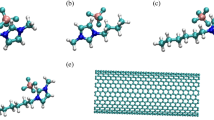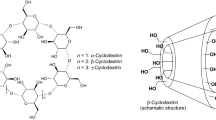Abstract
Solvents play an important role in host-guest intermolecular interactions. The kinetics and residence time of Toussaintine-A (TouA) unbinding from chitosan was investigated by means of well-tempered metadynamics and thermodynamic integration using two solvents, polar aprotic (DMSO), and polar protic (water). The kinetic rates were found to be strongly dependent on the solvent polarity; hence, the unbinding rate proceeded much faster in DMSO compared to water. DMSO tends to participate less in a chemical reaction by weakening the intermolecular interaction between chitosan and TouA due to lack of acidic hydrogen resulting in a reduction of the transition state. On the other hand, water, which ought to donate hydrogen atoms, sustains a strong interaction and hence large barrier heights. Consequently, this reduces the unbinding rate and increases the residence time. Binding free energy from thermodynamic integration suggests a thermodynamic stable chitosan-TouA complex in water than in DMSO.

Graphical abstract










Similar content being viewed by others
Availability of data and materials
All data are available on request to the corresponding author.
Code availability
All codes used in this work is as per the published.
References
Abraham M (1974) Solvent effects on transition states and reaction rates. Progress Phys Org Chem, pp 1–87
Fu IW, Markegard CB, Nguyen HD (2014) Solvent effects on kinetic mechanisms of self-assembly by peptide amphiphiles via molecular dynamics simulations. Langmuir 31(1):315
Papadakis R, Deligkiozi I (2019) In: Solvent effects, IntechOpen
Levy Y, Jortner J, Becker OM (2001) Solvent effects on the energy landscapes and folding kinetics of polyalanine. Proc Natl Acad Sci 98(5):2188
da Silva GC, Cardozo TM, Amarante GW, Abreu CR, Horta BA (2018) Solvent effects on the decarboxylation of trichloroacetic acid: insights from ab initio molecular dynamics simulations. Phys Chem Chem Phys 20(34):21988
Sheehan ME, Sharratt PN (1998) Molecular dynamics methodology for the study of the solvent effects on a concentrated diels-alder reaction and the separation of the postreaction mixture. Comput Chem Eng 22:S27
Slakman BL, West RH (2019) Kinetic solvent effects in organic reactions. J Phys Org Chem 32(3):e3904
Zandarashvili L, Esadze A, Kemme CA, Chattopadhyay A, Nguyen D, Iwahara J (2016) Residence times of molecular complexes in solution from nmr data of intermolecular hydrogen-bond scalar coupling. J Phys Chem Lett 7(5):820
Rwegasila E, Munissi JJ, Mubofu E, Nyandoro SS, Erasto P (2018) In vivo antimycobacterial studies of toussaintine a-chitosan nanocomposites. Tanzania Journal of Science 44(2):16
Shadrack DM, Swai HS (2019) Solvent effects on molecular encapsulation of Toussantine-a by chitosan nanoparticle: a metadynamics study. J Mol Liq 111434:292
Khezri A, Karimi A, Yazdian F, Jokar M, Mofradnia SR, Rashedi H, Tavakoli Z (2018) Molecular dynamic of curcumin/chitosan interaction using a computational molecular approach: Emphasis on biofilm reduction. Int J Biol Macromol 114:972
Tiwary P, Mondal J, Morrone JA, Berne B (2015) Role of water and steric constraints in the kinetics of cavity-ligand unbinding. Proc Natl Acad Sci 112(39):12015
Barducci A, Bussi G, Parrinello M (2008) Well-tempered metadynamics: a smoothly converging and tunable free-energy method. Phys Rev Lett 100(2):020603
Kirkwood JG (1935) Statistical mechanics of fluid mixtures. J Chem Phys 3(5):300
Ytreberg FM, Swendsen RH, Zuckerman DM (2006) Comparison of free energy methods for molecular systems. J Chem Phys 125(18):184114
Slabber CA, Grimmer CD, Robinson RS (2016) Solution conformations of curcumin in DMSO. J Nat Prod 79(10):2726
Hanwell MD, Curtis DE, Lonie DC, Vandermeersch T, Zurek E, Hutchison GR (2012) Avogadro: an advanced semantic chemical editor, visualization, and analysis platform. J Cheminformatics 4(1):17
Oda A, Okayasu M, Kamiyama Y, Yoshida T, Takahashi O, Matsuzaki H (2007) Evaluation of docking accuracy and investigations of roles of parameters and each term in scoring functions for protein–ligand docking using ArgusLab software. Bull Chem Soc Jpn 80(10):1920
Abraham MJ, Murtola T, Schulz R, Páll S., Smith JC, Hess B, Lindahl E (2015) GROMACS: High performance molecular simulations through multi-level parallelism from laptops to supercomputers. SoftwareX 1:19
Schmid N, Eichenberger AP, Choutko A, Riniker S, Winger M, Mark AE, van Gunsteren WF (2011) Definition and testing of the GROMOS force-field versions 54A7 and 54B7. European Biophys J 40(7):843
Schüttelkopf A. W., van Aalten DM (2004) PRODRG: a tool for high-throughput crystallography of protein–ligand complexes. Acta Crystallogr D Biol Crystallogr 60(8):1355
Gereben O, Pusztai L (2011) On the accurate calculation of the dielectric constant from molecular dynamics simulations: The case of SPC/E and SWM4-DP water. Chem Phys Lett 507(1-3):80
Nosé S (1986) An extension of the canonical ensemble molecular dynamics method. Mol Phys 57(1):187
Parrinello M, Rahman A (1981) Polymorphic transitions in single crystals: a new molecular dynamics method. J Appl Phys 52(12):7182
Bussi G, Donadio D, Parrinello M (2007) Canonical sampling through velocity rescaling. J Chem Phys 126(1):014101
Cheatham TI, Miller J, Fox T, Darden T, Kollman P (1995) Molecular dynamics simulations on solvated biomolecular systems: the particle mesh Ewald method leads to stable trajectories of DNA, RNA, and proteins. J Am Chem Soc 117(14): 4193
Hess B, Bekker H, Berendsen HJ, Fraaije JG (1997) LINCS: a linear constraint solver for molecular simulations. J Comput Chem 18(12):1463
Laio A, Parrinello M (2002) Escaping free-energy minima. Proc Natl Acad Sci 99(20):12562
Barducci A, Bonomi M, Parrinello M (2011) Metadynamics. Wiley Interdisciplinary Reviews: Computational Molecular Science 1(5):826
Bonomi M, Branduardi D, Bussi G, Camilloni C, Provasi D, Raiteri P, Donadio D, Marinelli F, Pietrucci F, Broglia RA, et al. (2009) PLUMED: A portable plugin for free-energy calculations with molecular dynamics. Comput Phys Commun 180(10): 1961
Limongelli V, Bonomi M, Parrinello M (2013) Funnel metadynamics as accurate binding free-energy method. Proc Natl Acad Sci 110(16):6358
Kang J, Rebek J. Jr. (1996) Entropically driven binding in a self-assembling molecular capsule. Nature 382(6588):239
Samanta S, Roccatano D (2013) Interaction of curcumin with PEO–PPO–PEO block copolymers: a molecular dynamics study. J Phys Chem B 117(11):3250
Patsahan T, Ilnytskyi J, Pizio O (2017) On the properties of a single OPLS-UA model curcumin molecule in water, methanol and dimethyl sulfoxide. Molecular dynamics computer simulation results. arXiv:1706.07253
Acknowledgements
DMS acknowledges the International Centre for Theoretical Physics (ICTP) for supporting his research visit and availing all research facilities. All authors are grateful to Prof. Alessandro Laio (SISSA) for his comments and discussion during the whole project.
Funding
DMS received the financial support from the world Bank, Tanzania, United Republic of Tanzania, through project no. PI:51847 and grant no. 5799-TZ.
Author information
Authors and Affiliations
Contributions
DMS conceived the study and designed the experiment. DMS and LWK performed all the experiments. DMS developed the first version of the manuscript. DMS, LWK, SSN, and HSS revised and worked on the manuscript to final stage of submission.
Corresponding author
Ethics declarations
Conflict of interests
The authors declare no competing interests.
Additional information
Publisher’s note
Springer Nature remains neutral with regard to jurisdictional claims in published maps and institutional affiliations.
Rights and permissions
About this article
Cite this article
Shadrack, D.M., Kiruri, L.W., Swai, H. et al. Solvent effects on host-guest residence time and kinetics: further insights from metadynamics simulation of Toussaintine-A unbiding from chitosan nanoparticle. J Mol Model 27, 127 (2021). https://doi.org/10.1007/s00894-021-04735-y
Received:
Accepted:
Published:
DOI: https://doi.org/10.1007/s00894-021-04735-y




